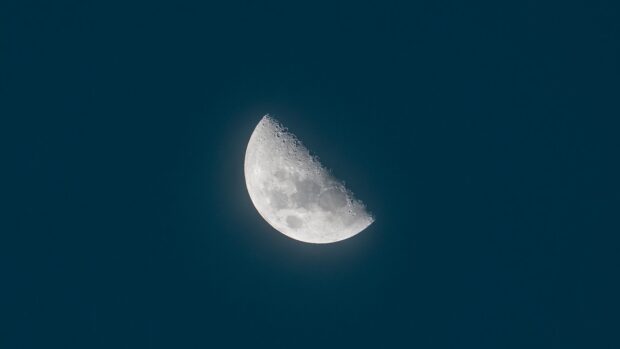Scientists have made a groundbreaking discovery regarding the composition of the Moon’s core, revealing that it closely resembles Earth’s core. Leading astronomer Arthur Briaud, along with a team of researchers from the Centre National de la Recherche Scientifique, conducted extensive simulations and analysis of existing data to uncover the likely contents of the Moon’s core. This finding has the potential to revolutionize our understanding of our planet’s oldest satellite. The relevance of the Moon’s core has never been greater, given the recent surge in space exploration. Multiple countries are now expressing their desire to not only land on the Moon but also establish sustainable communities there, utilizing cutting-edge technology and the available resources. Therefore, having a comprehensive understanding of the Moon’s core can greatly aid space agencies in realizing these ambitious projects. In this article, we will delve into how scientists have determined the possible form and composition of the Moon’s core. Additionally, we will explore the latest plans for developing lunar economies and settlements. So what exactly lies within the Moon’s core? Driven by their research, French astronomer Arthur Briaud and his colleagues discovered that the Moon’s inner core is a solid metal ball, surrounded by a molten outer layer. This conclusion was reached through a meticulous examination of data obtained from space missions and lunar laser-ranging experiments. Some of the key sources they analyzed include seismic data collected by NASA researchers in 2011, a high-quality map of the Moon’s gravitational field from the Gravity Recovery and Interior Laboratory (GRAIL), and precise measurements of distances between the Earth and specific lunar areas using Lunar Laser Ranging (LLR). By compiling this information, Briaud and his team were able to construct a comprehensive profile of the Moon’s core. They then ran various simulations to identify which profiles closely matched the known observations. Out of a total of 120,000 simulations, only 144 represented the selected profiles, as reported by the CNRS team. Through this rigorous process, the scientists were able to determine that the Moon’s core features a “low viscosity zone” deep in its mantle. This zone allows denser materials to flow towards the center, while lighter ones rise upward. Consequently, this explains the presence of minerals such as ilmenite, an iron-titanium oxide, in regions of the Moon that were once volcanic. In essence, the research conducted by the French team suggests that a Moon with a solid inner core and a viscous outer core accurately aligns with our current knowledge of this celestial body. The team also provided specific dimensions for both the inner and outer core. According to their findings, the radius of the inner core is approximately 160 miles or 258 km, while the outer core has a radius of 225 miles or 362 km. Commenting on the significance of this research, scientist Vishnu Viswanathan, who specializes in studying the Moon’s core, stated that expanding our knowledge of the Moon’s interior can have far-reaching implications. It can further our understanding not only of our ancient satellite but also of the broader concepts of space and time. Now, let’s delve into the latest projects pertaining to the Moon. It may initially seem far-fetched to think that countries are investing substantial resources into enabling humans to live on the Moon. However, this is precisely what the Defense Advanced Research Projects Agency (DARPA) and NASA are doing. They have jointly launched the LunA-10 project as a means to generate ideas that support lunar infrastructure. Michael Nayak, program manager of the DARPA Strategic Technology Office, elaborated on this initiative, stating, “For 65 years, DARPA has pioneered and de-risked technologies vital to civil space advancement. LunA-10 continues this rich legacy by identifying and accelerating key technologies that may be used by government and the commercial space industry, and ultimately to catalyze economic vibrancy on the Moon.” The objective of these agencies is to develop key industries, including mining, medicine, and construction, on the lunar surface. Consequently, they aim to transform these sectors into a thriving lunar economy. Nayak further added, “Just like DARPA’s foundational node of ARPANET grew into the sprawling web of the internet, LunA-10 is looking for those connective nodes to support a thriving commercial economy on the Moon.” Naturally, the establishment of these industries necessitates the construction of various structures. To this end, NASA has collaborated with the construction tech firm ICON. They aim to use lunar soil as a viable concrete material through their 3D printing construction system. The recent research conducted by CNRS can significantly contribute to ICON’s understanding of Moon soil and, consequently, assist in the development of superior construction materials derived from lunar resources. In conclusion, French astronomer Arthur Briaud and his team at the Centre National de la Recherche Scientifique have made a groundbreaking discovery regarding the composition of the Moon’s core. Their research indicates that it consists of a solid inner core and a molten outer layer, closely resembling Earth’s core. This finding aligns with our existing knowledge of the Moon’s composition, but it is important to note that further research may lead to new insights concerning our planet’s ancient satellite. For more details on this study, refer to the Nature journal publication titled “The lunar solid inner core and the mantle overturn.” To stay updated on the latest digital trends, visit Inquirer Tech.
Denial of responsibility! Vigour Times is an automatic aggregator of Global media. In each content, the hyperlink to the primary source is specified. All trademarks belong to their rightful owners, and all materials to their authors. For any complaint, please reach us at – [email protected]. We will take necessary action within 24 hours.


